(555 products available)










































































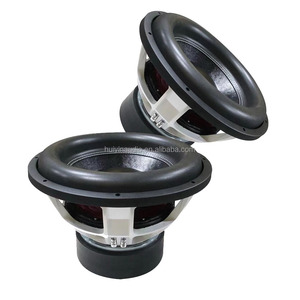
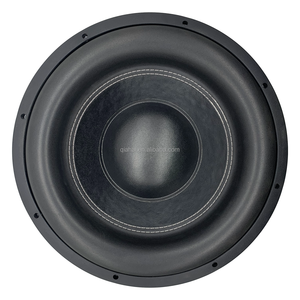
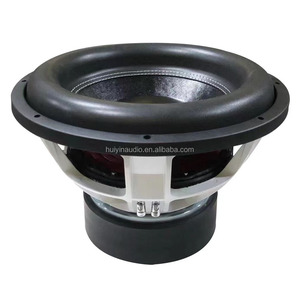
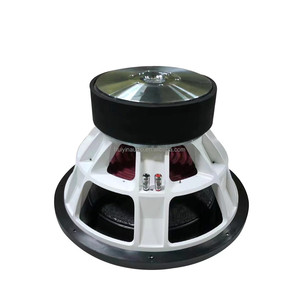
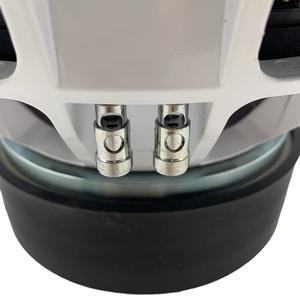

















































































































There are several types of competition subwooffer that are important for buyers to know. They include:
15-inch competition subwoofer
15-inch competition subwoofers are the most popular sizes for car audio systems. They produce deep bass and can handle high power, making them suitable for loud music. The 15-inch subs have a larger cone area that moves more air for increased bass output. They are installed in bigger enclosures that impact their performance. The 15-inch subs draw more power from the amp and may require upgrading.
18-inch competition subwoofer
18-inch competition subwoofers are much less common but offer significant advantages. The 18-inch subs move the most air and can reproduce the lowest bass frequencies. They are ideal for genres with extreme low-bass parts. The large subs have higher sensitivity ratings, so they can produce loud sounds with less power. Audiophiles who listen to music with deep bass prefer the 18-inch subs over smaller sizes.
12-inch competition subwoofer
12-inch competition subwoofers strike a balance between size and performance. They are versatile and suitable for various music styles. The 12-inch subs have good bass response without the drawbacks of larger woofers. They are more affordable and require less power.
Car audio competition subwoofers
Car audio competition subwoofers are designed for enthusiasts who want the loudest sound possible. They have features such as high excursion and high sensitivity ratings that contribute to higher sound levels. The subs are tested in competitions to verify their performance. Car audio competition subwoofers are more expensive than standard subs because of their specialized design.
Here are the specifications for the 15 competition subwoofers:
Power Handling
Subwoofers have the ability to handle high power. They have RMS ratings that range from 1200 to 5000 watts. They also have peak power ratings of 2400 to 10000 watts.
Voice Coils
The subwoofers have voice coils that are single or dual. They also have an impedance rating of 1, 2, 4, or 8 ohms. The voice coils are wound with aluminum or copper wire.
Magnet Weight
Subwoofers have powerful magnets that weigh 100 to 500 oz or more. These magnets are made from ferrite or neodymium materials.
Cone Material
The 15 competition subwoofers have cones made of different materials. Some of the materials include polypropylene, paper, Kevlar, carbon fiber, and aluminum.
Surround Material
They have surrounds made of rubber or foam materials. The surrounds are attached to the cone and the frame, and they are responsible for moving the cone back and forth.
Suspension
The subs have inner and outer diameter suspensions. The diameter of the inner and outer coil is 2, 3, 4, or 5 inches. The suspensions also have designs that include linear or progressive rate.
Frame
The subwoofer frame is designed to be strong and durable. It is made of stamped steel or cast aluminum. The frame also has a diameter that ranges from 10 to 20 inches.
Basket
The basket of the subwoofer is responsible for holding all the components together. It is made of steel or cast aluminum. The basket also has a venting system that helps to cool the voice coil.
Ferrofluid
The subwoofers voice coils have ferrofluid. The fluid works by improving cooling and also helps to dampen the movement of the voice coil.
Enclosure Type
Subwoofers have enclosures that are either ported or sealed. The enclosures are built to amplify sound and also protect the subwoofer from any damage.
Frequency Response
The frequency response of the subwoofers ranges between 20 to 200 Hz. This enables them to produce deep and powerful bass sounds.
Output SPL
The Sound Pressure Level (SPL) output of the subwoofers is measured in decibels (dB). The SPL output of the subwoofers ranges from 130 to 160 dB.
Course of Action
The subwoofers come with a course of action that helps to enhance their performance. The course of action includes a built-in crossover and equalizer.
Integrated Amplifier
Some 15-inch competition subwoofers have integrated amplifiers. The amplifiers are made specifically to power the subwoofer.
Protection Circuitry
Some subwoofers have a protective circuit. The circuit protects the subwoofer from damage that can be caused by overheating or overpowering.
When it comes to maintaining 15 competition subwoofers, there are certain things that need to be done for them to continue working efficiently.
1. Cleaning
The subwoofers need to be cleaned regularly. This is to get rid of dirt, dust, and debris that can interfere with the sound quality. When cleaning, a soft brush and a microfiber cloth should be used. Also, users should be careful not to damage the cone and the surrounding materials.
2. Tightening screws and bolts
Users should ensure that all screws and bolts are tightened properly. Loose screws and bolts can lead to unwanted vibrations and also affect sound quality.
3. Inspecting the suspension system
The competition subwoofers' suspension systems should be inspected regularly for any signs of wear or damage. In case of damaged parts, they should be replaced immediately to maintain optimal performance.
4. Properly adjusting gain and crossover settings
The gain and crossover settings of the subwoofers should be properly adjusted. This is to prevent distortion and also protect the subwoofer from damage due to overexertion.
5. Checking the enclosure
The competition subwoofers are housed in an enclosure. Therefore, users should check the condition of the enclosure to ensure that the subwoofer is protected and also provides optimal performance.
6. Inspecting the electrical connections
Users should inspect the electrical connections of the subwoofers. This is to make sure that they are securely connected. Loose connections can lead to power loss and also affect the performance of the subwoofer.
7. Avoiding overloading and overheating
Users should avoid overloading and overheating the subwoofer. This can occur by playing music at high volume for long periods of time. Overheating can lead to permanent damage to the subwoofer.
8. Storing properly
In case the subwoofers are not in use, they should be stored properly. The storage area should be dry and free from extreme temperatures. This is to prevent damage to the subwoofer due to environmental factors.
With so many options available in the market, choosing a competition-grade subwoofer can be a daunting task. Here are some factors to consider:
It’s crucial to have a basic understanding of how to install and replace 15 competition subwoofers before making a purchase. Here’s a step-by-step guide that helps to install and replace the competition subwoofers:
Q1: How do you break in a 15 subwoofer?
A1: A properly broken-in subwoofer will sound better and last longer. To break a 15-inch subwoofer, play low-volume music with bass for 8-12 hours. Then, increase the volume to medium and continue for another 8-12 hours. After that, users can use the subwoofer at their desired volume level.
Q2: What is a good amp for a 15-inch subwoofer?
A2: The amplifier should match the subwoofer's power handling. For a 15 2 ohm subwoofer, an amp that produces 800-1200 watts RMS at 2 ohms is ideal. For a 15 1 ohm subwoofer, an amp that produces 1200-1500 watts RMS at 1 ohm is needed. Always use an amp that is within the subwoofer's power range.
Q3: Can a 15-inch subwoofer play midrange?
A3: While 15-inch subwoofers excel at deep bass, they can reproduce midrange sounds. However, their midrange performance may not be as clear as dedicated midrange speakers. For best results, pair the subwoofer with a midrange speaker or a full-range speaker for balanced sound.
Q4: Can I connect two 15-inch subwoofers to one amplifier?
A4: Yes, it's possible to connect two 15-inch subwoofers to a single amplifier. The user needs to wire the subwooshes either in series or parallel, depending on the desired impedance. Ensure the amp can handle the combined impedance and power both subs equally.
Q5: What is the lifespan of a 15-inch subwoofer?
A5: With proper usage and maintenance, a 15-inch subwoofer can last for 8-12 years or more. Factors affecting lifespan include exposure to extreme temperatures, humidity, dust, and overdriving the speaker.